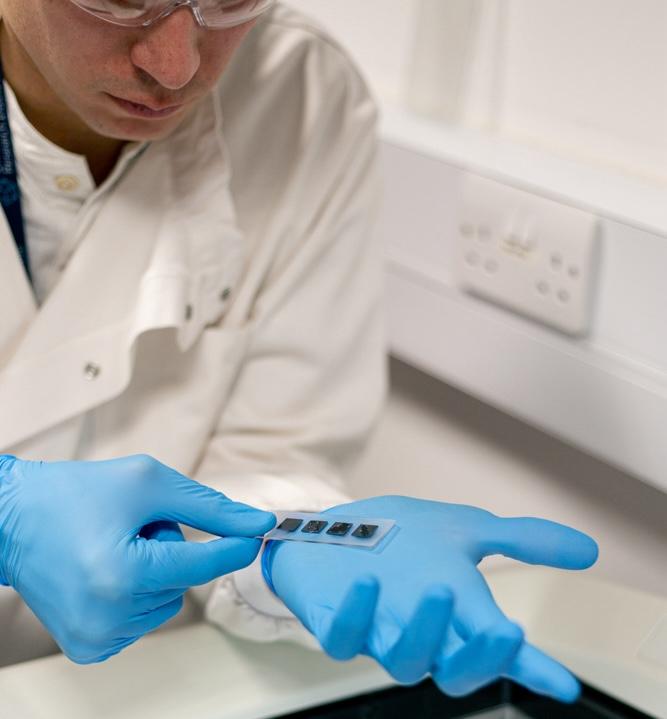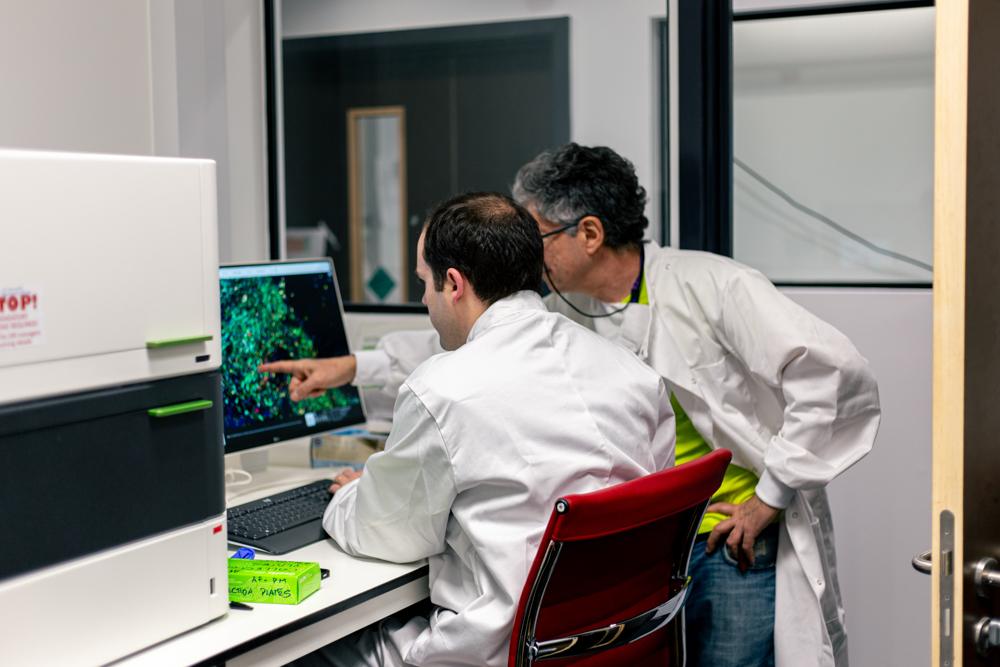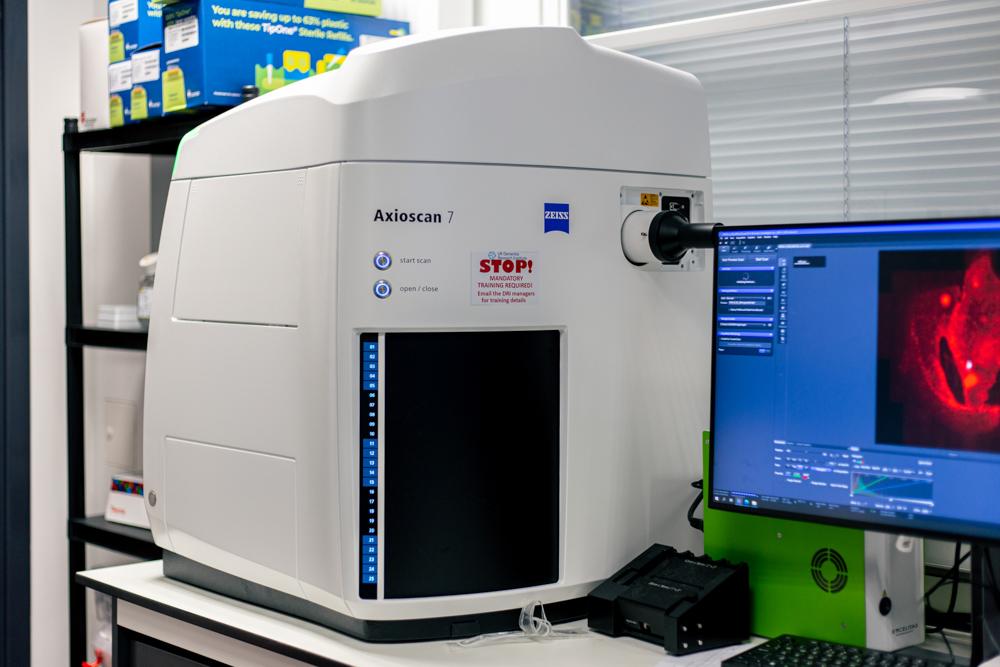A facility delivering cellular and spatial precision
Single cell and spatial omics are cutting-edge techniques in molecular biology that provide unprecedented insights into cellular function and tissue organisation.
Single cell 'omics analyses individual cells, revealing unique gene expression patterns and cellular heterogeneity within populations. Spatial 'omics maintains tissue context, mapping molecular information to specific locations within a sample.
Together, these approaches offer a comprehensive view of biological systems, combining detailed cellular profiles with spatial resolution. This powerful combination is revolutionising our understanding of complex tissues and importantly disease processes, paving the way for personalised medicine and drug discovery.
The UK DRI Single Cell and Spatial Omics Facility, based in the Cruciform building at UCL, provides experimental services in single cell and spatial 'omics, assistance in experimental design, access to equipment and bioinformatic support to UK DRI and visiting researchers. The team also provide expert advice and guidance in local facilities for single cell and spatial transcriptomics at UK DRI centres.

Research

Cutting edge equipment and expert support
The brain is composed of many specialised cells. Data produced using ‘bulk’ methods provide an average measure across all the cells of the tissue. Single cell approaches on the other hand provide means to characterise the transcripts, proteins and cis-regulatory landscape of individual cells.
For this purpose, the Single Cell and Spatial Omics Facility (SCSO) provides a variety of single cell methods (10x Genomics scRNA-seq, scATAC-seq, ‘Multiome’; Scale biosciences and Parse biosciences split-seq methods and Fluent biosciences PIP-seq). Moreover, the SCSO offers a nuclei isolation service from frozen tissue. SCSO will soon also have a BD Melody FACs-sorter allowing researchers to enrich in the cell preparations and nuclei suspensions in cell types of interest.
However, a challenge with single cell methods is that they rely on dissociating cells or isolating nuclei, and, in doing so vital spatial information regarding the cells’ surroundings and microenvironment is lost. For this reason, SCSO also provides several spatial methods to investigate transcript, protein and cis-regulatory landscape on tissue sections. SCSO provides access to three instruments: a Nanostring GeoMx and CosMx instruments and a Vizgen Merscope. We also offer Curio Seeker and Trekker preparations and GCAT Bio’s Stereoseq for researchers interested in sequencing-based spatial approaches. We are in the process of validating spatial ATAC-seq and spatial CUT & Tag methods employing AtlasXomics technology.
Resources
Find details on services, techniques/technologies, methods, samples and accessing the Single Cell and Spatial Omics Facility (SCSO) below:
Services
The SCSO Facility offers the following services to UK DRI researchers:
- Help with experimental planning, costing and grant writing employing single cell or spatial techniques
- Access to equipment (do experiment yourself at Cruciform)
- Full experimental workflow (from tissue to sequencing library preparation)
- Access to Illumina Nextseq-550 sequencer
- Bioinformatic assistance for analysis of single cell and spatial data
- Access to SCSO Server for carrying out your data analysis on your own or with SCSO staff’s assistance
Techniques/Technologies:
The SCSO Facility offers several spatial methods that are either provided by Facility staff or are accessible to advanced users in a self-service model with access to all necessary reagents and additional equipment for sample preparation. We provide initial training and continued assistance to all researchers that wish to carry out the experiments themselves.
- Nanostring GeoMX
- Nanostring CosMX
- Vizgen Merscope
- BD FACSMeloldy
- Flow Cytometer
- Illumina NextSeq-550
Spatial transcriptomics methods:
| Name | Tissue type | Readout | Instrument required | Genes assayed |
| GeoMx DSP | FF/FFPE | Sequencing or nCounter* | Yes | Mouse, human whole transcriptome or dedicated panels |
| CosMx SMI | FF/FFPE | Imaging | Yes | 1K or 6K panel |
| Merscope | FF | Imaging | Yes | Custom gene panels 140 or 500 genes |
| Curio Seeker (Slide-seq v2) | FF | Sequencing | No | All polyadenylated transcripts |
| Curio Trekker | FF | Sequencing | No | All polyadenylated transcripts |
| Stereoseq | FF | Sequencing** | No | All polyadenylated transcripts |
* Nanostring nCounter instrument is available at dedicated Edinburgh facility and UCL facility
** Requires sequencing using MGI instruments available to UK DRI researchers through Imperial College London BRC facility.
Using the SCSO Facility
If you would like to work with us, please contact us via e-mail (ukdri.scst@ucl.ac.uk) and tell us about your project. We request that all Facility clients first discuss their project with us and commit to signing a project form and accept quote provided by Facility.
Sending samples to SCSO
We accept samples in person, via courier or by post and can advise on the best way to send your samples. Please make sure you have all necessary documents confirming compliance with Human Tissue Act before sending your samples if working with human tissue samples.

A Zeiss Axioscan 7 microscope available as part of the Single Cell and Spatial Omics Facility
